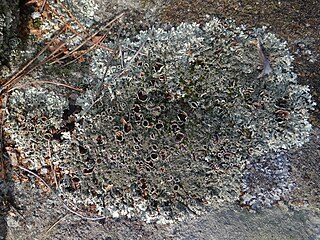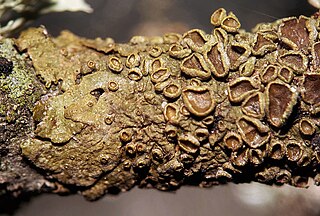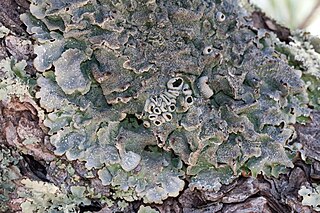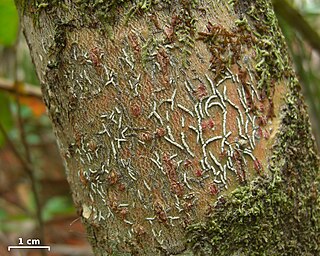
Erik Acharius was a Swedish botanist who pioneered the taxonomy of lichens and is known as the "father of lichenology". Acharius was famously the last pupil of Carl Linnaeus.

Parmelia is a genus of medium to large foliose (leafy) lichens. It has a global distribution, extending from the Arctic to the Antarctic continent but concentrated in temperate regions. There are about 40 species in Parmelia. In recent decades, the once large genus Parmelia has been divided into a number of smaller genera according to thallus morphology and phylogenetic relatedness.
Everniopsis is a fungal genus in the family Parmeliaceae. It consists of a single species, the bark-dwelling lichen Everniopsis trulla, which occurs in Africa and South America.

Imshaugia is a genus of seven species of foliose lichens in the family Parmeliaceae. They are commonly known as starburst lichens.

Xanthoparmelia conspersa, commonly known as the peppered rock-shield, is a foliose lichen and the type species of genus Xanthoparmelia. It is widely distributed in temperate zones, and has been recorded from Japan, Europe, Africa, North America, and South America.

Parmotrema rampoddense, commonly known as the long-whiskered ruffle lichen, is a species of foliose lichen in the family Parmeliaceae. It is widely distributed in tropical regions and grows on the bark of oak and palm trees.

Parmotrema arnoldii, commonly known as the powdered ruffle lichen, is a widely distributed species of lichen in the family Parmeliaceae. It has been recorded from Africa, Asia, Europe, Oceania, Macaronesia, and North and South America.
Bulbothrix meizospora is a species of foliose lichen in the family Parmeliaceae. It is found in Africa, Asia, and South America, where it grows on tree bark.

Pyxine sorediata, commonly known as mustard lichen, is a widely distributed species of foliose lichen in the family Caliciaceae. It has a subtropical to warm temperate distribution, and grows on bark, rocks, and moss as substrates. Pyxine sorediata has been reported from regions of North America, Europe, Africa, Asia, and Australasia.

Melanohalea subolivacea, commonly known as the brown-eyed camouflage lichen, is a species of foliose lichen in the family Parmeliaceae.

Punctelia rudecta, commonly known as the rough speckled shield or the speckleback lichen, is a North American species of foliose lichen in the family Parmeliaceae. This species can be readily identified by the light color of the thallus underside, the relatively large lobes at the edges of the thallus, and the tiny white pores present on the top of the thallus that are characteristic of the genus Punctelia. The lichen is quite abundant and widespread in the eastern and southeastern United States, although it also occurs in Canada and northern Mexico, but is less common in these regions. The lichen usually grows on bark, and less commonly on shaded rocks. There are several lookalike Punctelia species; these can often be distinguished from P. rudecta by differences in distribution or in the nature of the reproductive structures present on the thallus.
Punctelia subpraesignis is a species of foliose lichen in the family Parmeliaceae. It occurs in Mexico, South America, and East Africa, where it grows on bark and on rocks. Major characteristics of the lichen that distinguish it from other Punctelia species include the C+ and KC+ rose spot tests of the medulla, ascospores that are smaller than 20 μm, and unciform (hooklike) conidia.

Punctelia hypoleucites, commonly known as the southwestern speckled shield lichen, is a species of foliose (leafy) lichen in the family Parmeliaceae. First formally described by Finnish botanist William Nylander as a species of Parmelia, it was transferred to the genus Punctelia in 1982. The lichen is found in Africa, North America, and South America, where it grows on the bark of both hardwood and coniferous trees. Its greenish-grey thallus is covered with tiny white pseudocyphellae – minute holes in the thallus surface that facilitate gas exchange. Some macroscopic features that help distinguish this species from other related members of the genus include the presence and the structure of the apothecia, the absence of asexual surface propagules, and the light brown color of the thallus undersurface. Chemically, the presence of lecanoric acid in the medulla and atranorin in the cortex help distinguish it from lookalikes.

Punctelia bolliana, the eastern speckled shield lichen, is a species of foliose lichen in the family Parmeliaceae. It is found in North America, with a distribution extending from the Canadian province of Ontario south to the central and northeastern United States and Mexico. It grows on the bark of both deciduous trees and coniferous trees. The combination of characteristics that distinguishes this species from others in genus Punctelia are the absence of the vegetative propagules isidia and soralia, a pale brown lower thallus surface, and the presence of the secondary chemical protolichesterinic acid in the medulla.

Punctelia graminicola is a species of foliose (leafy) lichen in the family Parmeliaceae. It grows on rocks, and, less frequently, on bark in North America, South America, and East Africa. It has a blue-grey thallus measuring up to about 15 cm (6 in), covered with tiny pores called pseudocyphellae. Sometimes the lichen forms small lobes that project out from the surface. Fruiting bodies are uncommon in this species; if present, they resemble small cups with a brown internal disc measuring 3–10 mm (0.1–0.4 in) in diameter. A lookalike species, Punctelia hypoleucites, is not readily distinguishable from Punctelia graminicola by appearance or habitat alone; these species can only be reliably differentiated by examining the length of their conidia.

Parmelia fraudans is a species of foliose lichen in the family Parmeliaceae. It is found in Europe and North America, where it grows on rocks.

Imshaugia aleurites, commonly known as the salted starburst lichen, is a species of foliose lichen in the family Parmeliaceae. It has a wide distribution in Europe and North America, and has also been recorded in China.

Dyplolabia afzelii is a species of corticolous (bark-dwelling), script lichen in the family Graphidaceae. It has a pantropical distribution. The lichen has a thallus with colours ranging from yellow to pale olive buff, dark brownish tan, or grey, characterised by its smooth texture and considerable thickness. Its ascomata are lirelline, often raised from the thallus surface and concealed under a powdery white layer.

Physciella chloantha is a species of foliose lichen in the family Physciaceae. The lichen, which occurs in diverse regions including the Upper Midwest of the US, Europe, Japan, Pakistan, and European Russia, is common in certain areas. Its thallus forms circular patches up to 3 cm in diameter, made up of many small, discrete lobes that can grow together to cover large areas, often intermingling with other lichen species. These lobes, which vary from short and rounded to slightly elongated, have numerous soralia on their edges and surfaces, while the undersides are white to pale tan with sparse rhizines. Apothecia are uncommon in this species. Physciella chloantha is known to grow on bark and on rocks.

Melanohalea exasperatula, commonly known as the lustrous camouflage lichen or lustrous brown-shield, is a species of corticolous (bark-dwelling) foliose lichen in the family Parmeliaceae. It has a widespread global distribution and is common in both Europe and northern North America. Its thallus can grow up to 5 cm (2 in) in diameter, with marginal lobes up to 5 mm broad. The upper surface is pale olive-green to red-brown, with isidia that are unbranched, inflated, and hollow. It can be distinguished from similar species by the shape and structure of these isidia. The lower surface of the thallus is pale tan to pale brown with scattered, pale rhizines. Apothecia are uncommon, while pycnidia and secondary metabolites have not been observed in this species. The lack of defensive chemicals makes it vulnerable to grazing by slugs and snails. The evolutionary history of Melanohalea exasperatula is linked to major climatic events during the Miocene and Pliocene epochs.
















